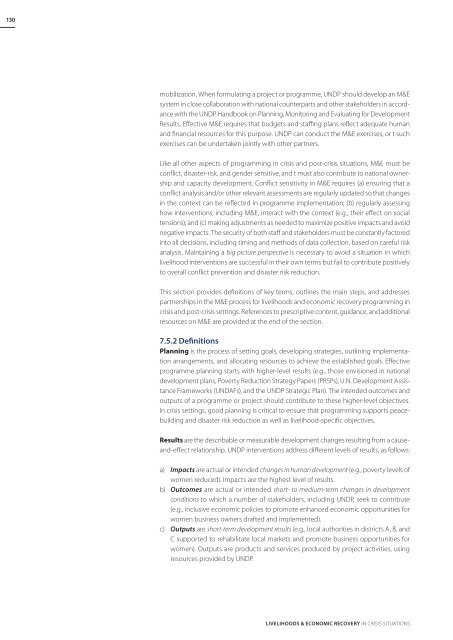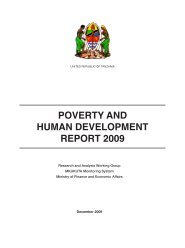Download PDF (4.08 MB) - ReliefWeb
Download PDF (4.08 MB) - ReliefWeb
Download PDF (4.08 MB) - ReliefWeb
You also want an ePaper? Increase the reach of your titles
YUMPU automatically turns print PDFs into web optimized ePapers that Google loves.
130<br />
mobilization. When formulating a project or programme, UNDP should develop an M&E<br />
system in close collaboration with national counterparts and other stakeholders in accordance<br />
with the UNDP Handbook on Planning, Monitoring and Evaluating for Development<br />
Results. Effective M&E requires that budgets and staffing plans reflect adequate human<br />
and financial resources for this purpose. UNDP can conduct the M&E exercises, or t such<br />
exercises can be undertaken jointly with other partners.<br />
Like all other aspects of programming in crisis and post-crisis situations, M&E must be<br />
conflict, disaster-risk, and gender sensitive, and t must also contribute to national ownership<br />
and capacity development. Conflict sensitivity in M&E requires (a) ensuring that a<br />
conflict analysis and/or other relevant assessments are regularly updated so that changes<br />
in the context can be reflected in programme implementation; (b) regularly assessing<br />
how interventions, including M&E, interact with the context (e.g., their effect on social<br />
tensions); and (c) making adjustments as needed to maximize positive impacts and avoid<br />
negative impacts. The security of both staff and stakeholders must be constantly factored<br />
into all decisions, including timing and methods of data collection, based on careful risk<br />
analysis. Maintaining a big picture perspective is necessary to avoid a situation in which<br />
livelihood interventions are successful in their own terms but fail to contribute positively<br />
to overall conflict prevention and disaster risk reduction.<br />
This section provides definitions of key terms, outlines the main steps, and addresses<br />
partnerships in the M&E process for livelihoods and economic recovery programming in<br />
crisis and post-crisis settings. References to prescriptive content, guidance, and additional<br />
resources on M&E are provided at the end of the section.<br />
7.5.2 Definitions<br />
Planning is the process of setting goals, developing strategies, outlining implementation<br />
arrangements, and allocating resources to achieve the established goals. Effective<br />
programme planning starts with higher-level results (e.g., those envisioned in national<br />
development plans, Poverty Reduction Strategy Papers (PRSPs), U.N. Development Assistance<br />
Frameworks (UNDAFs), and the UNDP Strategic Plan). The intended outcomes and<br />
outputs of a programme or project should contribute to these higher-level objectives.<br />
In crisis settings, good planning is critical to ensure that programming supports peacebuilding<br />
and disaster risk reduction as well as livelihood-specific objectives.<br />
Results are the describable or measurable development changes resulting from a causeand-effect<br />
relationship. UNDP interventions address different levels of results, as follows:<br />
a) Impacts are actual or intended changes in human development (e.g., poverty levels of<br />
women reduced). Impacts are the highest level of results.<br />
b) Outcomes are actual or intended short- to medium-term changes in development<br />
conditions to which a number of stakeholders, including UNDP, seek to contribute<br />
(e.g., inclusive economic policies to promote enhanced economic opportunities for<br />
women business owners drafted and implemented).<br />
c) Outputs are short-term development results (e.g., local authorities in districts A, B, and<br />
C supported to rehabilitate local markets and promote business opportunities for<br />
women). Outputs are products and services produced by project activities, using<br />
resources provided by UNDP.<br />
Livelihoods & Economic Recovery in Crisis Situations





